- v50 information can now be added to pages in the main namespace. v0.47 information can still be found in the DF2014 namespace. See here for more details on the new versioning policy.
- Use this page to report any issues related to the migration.
Difference between revisions of "v0.31:Raw adamantine"
m (→Veining) |
m |
||
| Line 46: | Line 46: | ||
One serious downside to mining veins of raw adamantine is that digging too deeply into the hollow section will eventually lead to a certain [[DF2010:Hidden Fun Stuff|spoiler]], triggering [[losing|dangerously large amounts of fun]] which can and usually will wipe out even a mature, heavily defended fortress. | One serious downside to mining veins of raw adamantine is that digging too deeply into the hollow section will eventually lead to a certain [[DF2010:Hidden Fun Stuff|spoiler]], triggering [[losing|dangerously large amounts of fun]] which can and usually will wipe out even a mature, heavily defended fortress. | ||
| + | |||
| + | Adamantine can be found in vertical pillars in {{L|Magma sea}}. This makes mining difficult, as one must either drain the area around the pillar to mine the pillar fully, or in cases of thicker pillars, mine out only the interior without breaching the exterior layer (and thus flooding the interior with magma). | ||
| + | |||
| + | ==Storage== | ||
| + | Raw Adamantine is stored in stone stockpiles with "Raw Adamantine" enabled in that stockpile's 'other stone' category. | ||
| + | |||
| + | However once strands are extracted, they are stored in a cloth pile. It is unfortunately impossible to directly segregate adamantine from plant fiber and silk cloth, because all cloth apparently counts as non-plant/animal products as far as the game is concerned, and adamantine does not appear as a thread/cloth type in the cloth custom stockpile menu. To create a stockpile for adamantine strands designate a cloth stockpile set to accept no types of thread or cloth and tell this stockpile to take from all other cloth stockpiles. | ||
| + | |||
| + | == Processing == | ||
| + | |||
| + | Adamantine strands are extracted from {{l|raw adamantine}} at a {{l|craftsdwarf's workshop}}. The {{l|strand extraction}} labor must be enabled for a dwarf to perform the extraction. The process is extremely slow for an unskilled laborer. | ||
Revision as of 23:02, 3 April 2010
| This article is about an older version of DF. |
| ||||||||||||||||||||||||||||||||||||
| Uses | ||||||||||||||||||||||||||||||||||||
|---|---|---|---|---|---|---|---|---|---|---|---|---|---|---|---|---|---|---|---|---|---|---|---|---|---|---|---|---|---|---|---|---|---|---|---|---|
| Location | ||||||||||||||||||||||||||||||||||||
| ||||||||||||||||||||||||||||||||||||
| Properties | ||||||||||||||||||||||||||||||||||||
The ore of adamantine is absurdly valuable, and can be processed into one of the most valuable material in the game, both in monetary worth and utility. Its discovery is both a boon and a bane; it has a massive value even unrefined, and weapons and armor made from it are very likely among the best possible. Its high melting point means you can easily use it to build magma-safe mechanisms and floodgates, but this is not recommended due to its scarcity and value in other items.
Raw adamantine has a Material Multiplier of x250. For a comparison to other mined materials, generic stone has a MM of x1, obsidian x3, silver nuggets x 10, and Gold nuggets x30. Processed adamantine "metal" has a multiplier of x300, the highest in the game of any material.
Adamantine is so valuable, both in price and usefulness, that a special message pops up when your miners discover the first vein of it.
Location
Every map can contain adamantine, regardless of the location. Very small maps can lack adamantine veins, usually however multiple veins are present (~1 per 4 embark squares).
Veining
Raw adamantine veins, in contrary to usual veins, span z-levels, leading almost directly upwards. Adamantine veins span up to and including 90 z-levels, possibly even more. The top most layers of the vein are full of adamantine whereas the lower levels are hollow, having a 2x2 squares empty core, some of the tiles inside can be floor tiles, others are simply open space.
Mining
Adamantine veins go directly upwards, thus once you discovered the location of a vein in one z-level you can easily trace it down to the very bottom.
One serious downside to mining veins of raw adamantine is that digging too deeply into the hollow section will eventually lead to a certain spoiler, triggering dangerously large amounts of fun which can and usually will wipe out even a mature, heavily defended fortress.
Adamantine can be found in vertical pillars in Template:L. This makes mining difficult, as one must either drain the area around the pillar to mine the pillar fully, or in cases of thicker pillars, mine out only the interior without breaching the exterior layer (and thus flooding the interior with magma).
Storage
Raw Adamantine is stored in stone stockpiles with "Raw Adamantine" enabled in that stockpile's 'other stone' category.
However once strands are extracted, they are stored in a cloth pile. It is unfortunately impossible to directly segregate adamantine from plant fiber and silk cloth, because all cloth apparently counts as non-plant/animal products as far as the game is concerned, and adamantine does not appear as a thread/cloth type in the cloth custom stockpile menu. To create a stockpile for adamantine strands designate a cloth stockpile set to accept no types of thread or cloth and tell this stockpile to take from all other cloth stockpiles.
Processing
Adamantine strands are extracted from Template:L at a Template:L. The Template:L labor must be enabled for a dwarf to perform the extraction. The process is extremely slow for an unskilled laborer.
